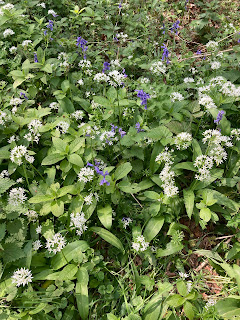Small mammal trapping
On the morning of a rather brisk and drizzly day in Norwich, the first year Ecology and Conservation students of UEA gathered to practice small mammal trapping and identification. The traps had been pre-laid the night before and some had promising signs. We collected the traps from the tangle of brambles and laid them out. The ones that had not been tripped were set aside and the ones with closed doors were assembled for opening.
All 60 traps laid out, ready to be inspected.
A close-up of a Longworth trap, showing the opening for the mammal to enter and the larger 'house' at the back.
We used Longworth traps, consisting of a trapping mechanism and a 'house' where the mammal shelters and eats the food provided. When trapping mammals, the types of mammals that might be caught need to be considered, especially when providing them with the food needed to survive until the traps are collected. Mice are granivorous, meaning they mostly eat grains, so we provided a generous helping of sunflower seed hearts to keep them happy. Shrews are insectivores, so they were tempted by the delicious castors (blowfly pupae). And voles are herbivorous, so would be delighted with the tasty hay, including dried flower heads. The hay also provides a sort of bedding for any small mammal in the trap, helping them to feel safe and warm. All traps also had a small chunk of apple and carrot inside to provide a water source that wouldn't just leak out of the trap. And the key to any small mammal's heart is, apparently, peanut butter! A healthy dollop was added to each trap. This banquet proves too tempting for many small mammals who wander in, tripping the trap on their way and shutting the door behind them.
The key piece of kit for examining small mammals is, of course, a large, sturdy plastic bag. The contents of the trap are gently tipped into the plastic bag so that any mammals inside can be seen without stressing them too much by handling them lots. This allows for (relatively) easy weighing, sexing and observation, all whilst allowing the mammal to run around inside the bag, doing its best to evade being observed!
A female Wood Mouse, washing her face whilst being examined in the bag.
A disgruntled male Wood Mouse, wishing he could continue nibbling a sunflower seed, I suspect!
Of the 60 traps initially laid out, only 9 mammals were caught, and all were Wood Mice (Apodemus sylvaticus). Most were quite obliging. A mixture of males and females were caught, differentiated by the distance between their two genital openings, far apart for the males and closer together in females. The mice were a good range in weight too, the largest being a whopping 28 grams, a very round mouse. This all suggests quite a healthy Wood Mouse population, even though not many were caught, I was assured that it has been worse, with a hit rate of 1/200 in the past!
Wood Mice don't actually hibernate, somewhat unusual for a British mammal, but can go into a state of torpor (deep sleep) if the winter is particularly chilly. However, they are relatively short-lived animals due to high levels of predation, mostly before they reach adulthood. Fortunately, they do have a funky defence mechanism against predators- they can shed some of the skin on their tails!
It was a little unfortunate that we did not get to see any other species today, but this is perhaps because they are a little more shy and wary of the traps, so may emerge in future trapping sessions instead.
After the mice had been catalogued, they were released back into the bushes, and all scampered away happily. We then reassembled the traps, restocking them with food, and laid them out again, so they could be checked again the next morning.
If you would like to read more information about Wood Mice you can visit: Wood mouse (Apodemus sylvaticus) – British Mammals - Woodland Trust
(All photos taken by me, all trapping done under GL01 license from Natural England)







Comments
Post a Comment